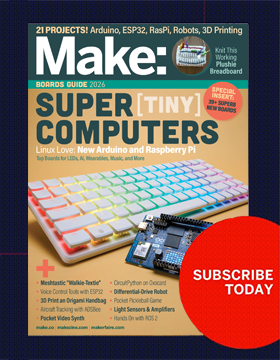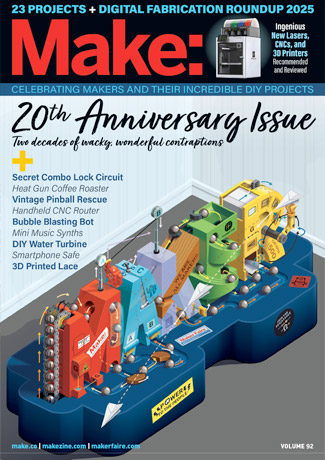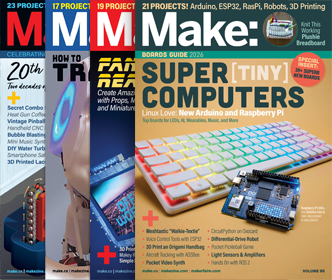
Whether serving drinks, telling jokes, or hitting each other with blunt objects, robots are everywhere and multiplying. From the weird to the wise, funky to functional, we love robots at Make:, and we’re excited to see what makers and their teams can cook up this National Robotics Week. Here’s a handful of inspiring projects we think you’ll enjoy this week. From programming to mechanics, from circuits to servos, there’s surely something here to help get you started on your next robot creation.
Know Your Combat Robots! A Field Guide to Competition Weight Classes and Weapons

People build robots to explore challenging environments, aid in tedious tasks, and because it’s fun to watch them beat each other up. If you’re wondering which robot combat league is right for you, Peter Garnache walks through the different classes of bot, from Fairyweight to Heavyweight, and gives you an idea of what you can expect from each. He also covers class modifiers and gives a thorough look into weapons for robot combat. Battling your bot may be glorious, financially devastating, or both, but at least this primer will help you make the right first move.
Build Your First Combat Bot!

Brandon Bennett Young walks through Kerfuffle, a cheap 1lb Antweight robot that’s great for first-time bot battlers. Its 3D-printed parts are easy to replace when/if they’re damaged, and can be made on an old entry-level 3D printer. The lifter arm does double duty as a weapon, or to flip itself back up after a rough hit. Once you’ve got a handle on the lifter, Brandon has some tips for weapons to play with next.
Anyone Can Use AI

Maybe destructive robots aren’t your thing and you’re looking for something a little bit more constructive. If you want an entry-level robot that doesn’t involve any smashing or bashing, Reade Richard and Andy Forest show you how to get started with a simple AI bot. You don’t need a 3D printer for this one, just a way to cut out cardboard. Using the beginner-friendly micro:bit board, this tutorial will hold your hand as you make your first AI project and run it on a homemade toy truck.
Hey Robot! Build Your Own AI Companion

In this DigiKey-sponsored project, Jovan Moss and Sean Himmel run a large language model on an embedded computer and have conversations with a shoulder-mounted companion bot. A couple steps up from MakeCode on a cardboard robot, Digit is an expressive animatronic creation, capable of listening and responding to human conversation reasonably well. It’s impressive to see an LLM, even a small one, running offline in 2024. Sean breaks down the mechanisms behind the LLM, helping you get an understanding of how it works, why they made the choices they made, and how to set up and run your own on a Raspberry Pi 5.
Build a Cuddly, Plush Companion Robot With Cute LED Ears

Debra Ansell’s plush robots are a lot cuddlier than your average 3D-printed companion bot, but they still pack servos, LEDs, and touch sensors to make them a responsive animated friend. Rosie the Radiant Rodent runs Circuit Python on an Adafruit Feather, so there are a lot of options for expanding the hardware on this easier-to-code robot. Debra not only wrote a thorough how-to but ends it with a few other examples to show off a range of capabilities.
Animatronic Singing Spirits: Building Musical Ghosts With Free Software

Animation is tedious, and programming robot animations can be excruciating. If you’re trying to figure out how to code an animatronic robot that you just made, you’ll do yourself a favor by checking out Bottango. Developer Evan McMahon shows off how to use this free animatronic software using a couple of dancing ghosts as an example. They’re excellent Halloween decorations by themselves, but it’s easy to say how the lessons here can be expanded and applied to more involved and intricate builds.
Smart3: The Self-Solving Rubik’s Cube

It takes the world record holder just over three seconds to solve a Rubik’s Cube, and it takes beginner solvers 3-5 minutes. This levitating, self-solving Rubik’s Cube by Takashi Kaburagi will probably take longer to make than that, but if you ask me it’s infinitely more impressive. Even in the future of 2025, I’m still amazed to see how much capability and tiny parts were packed into such a tiny package. But if Takashi could do it without any CAD or 3D printing experience, I think there’s a decent chance the rest of us can make it happen too.
ADVERTISEMENT






